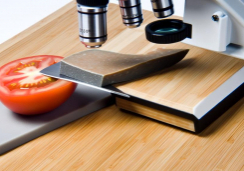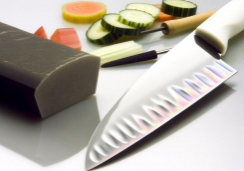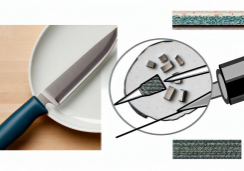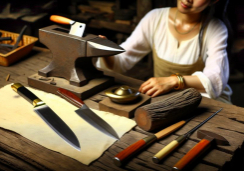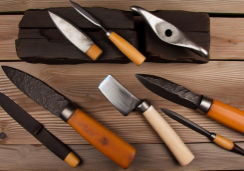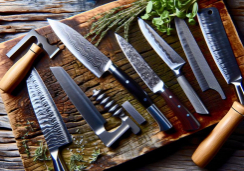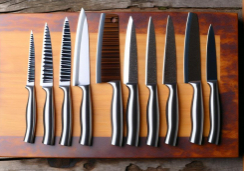3 Best Steel Varieties for Kitchen Knives
In the culinary world, your kitchen knife is as crucial as the sword is to a knight, a true extension of your culinary prowess that can make or break the meal you're preparing. You've probably wondered about the best steel to choose for that all-important blade.
While carbon steel is renowned for its sharpness and ease of sharpening, stainless steel boasts rust resistance and low maintenance, and the high-carbon stainless blend offers a middle ground with both sharpness and durability. As you stand at the crossroads of culinary excellence and practical functionality, it's vital to understand the subtle nuances that separate these metallurgical contenders.
But how do you discern which steel is the true champion of your kitchen arsenal? Stay with me, as we'll explore the characteristics that define the best kitchen knives, slicing through the facts to help you make an informed decision that will shape your cooking experiences for years to come.
Carbon Steel Advantages
Carbon steel, renowned for its superior edge retention, allows you to effortlessly maintain a razor-sharp cutting edge on your kitchen knives. This category of steel boasts a high carbon content relative to other steel types, typically ranging between 0.6% and 1.2%. This composition is critical for achieving the optimal balance of hardness and toughness in your blades, ensuring they resist deformation and dulling under repetitive use.
You'll appreciate that carbon steel knives sharpen more easily than their stainless steel counterparts. The absence of chromium in their alloy contributes to a less wear-resistant surface, which paradoxically facilitates resharpening. When you're honing the edge, the removal of metal is more efficient, allowing you to restore a keen edge with fewer strokes on a whetstone.
However, it's essential to note that carbon steel requires more meticulous care to prevent corrosion and rust. Without the chromium found in stainless steel that confers rust resistance, your carbon steel knives demand regular cleaning and immediate drying after use. Additionally, you'll need to apply a thin layer of food-grade mineral oil to protect the blade. This maintenance ensures longevity and peak performance, making carbon steel an excellent choice for chefs who prioritize edge sharpness and ease of maintenance.
Stainless Steel Properties
In contrast to carbon steel, stainless steel knives boast a significant chromium content, typically at least 10.5%, which imbues them with exceptional resistance to rust and corrosion. This inclusion of chromium forms a passive layer of chromium oxide on the steel's surface, effectively shielding it from the oxygen and moisture that typically lead to degradation.
You'll find stainless steel knives require less maintenance and are more forgiving in humid or damp environments. Their longevity is a key feature, but it's not the only property you should consider. Stainless steel also has a reputation for being less brittle than high-carbon steel, making it less prone to chipping or breaking during rigorous use.
However, the trade-off for stainless steel's durability is often its edge retention. It tends to dull faster than carbon steel, meaning you'll need to sharpen your knives more frequently. Additionally, the hardness of stainless steel varies depending on the specific alloy and heat treatment used. Common grades used in knife making, such as 440C, AUS-8, and VG-10, offer a balance between edge retention and ease of sharpening.
When selecting a stainless steel knife, pay attention to the specific alloy and its properties, as these will directly impact the blade's performance and maintenance requirements.
High-Carbon Stainless Blend
While stainless steel knives offer significant resistance to corrosion, those blended with high carbon content pair this durability with enhanced edge retention. You're likely familiar with the frustrations of a dull blade, and high-carbon stainless steel combats this issue by incorporating a higher percentage of carbon, which contributes to the knife's hardness and ability to maintain a sharp edge over time.
When considering high-carbon stainless steel for your kitchen knives, note the following technical advantages:
- Superior Hardness: The presence of carbon increases the steel's hardness, measured on the Rockwell scale. High-carbon stainless steels typically score higher on this scale, meaning they can take a sharper edge and hold it longer than lower-carbon varieties.
- Improved Wear Resistance: With increased hardness comes improved wear resistance. High-carbon stainless steel knives resist abrasions and scratches more effectively, ensuring a longer lifespan and consistent performance even with frequent use.
- Balanced Toughness: Despite being harder, high-carbon stainless steel maintains sufficient toughness. This balance prevents the knife from being too brittle, which can lead to chipping during heavy use or when cutting through harder materials.
What Makes These 3 Steel Varieties the Best for Kitchen Knives Compared to the Top 10 Varieties?
When it comes to choosing the best steel varieties for kitchen knives, three stand out among the top 10 varieties. High-carbon stainless steel offers excellent sharpness and edge retention, while Damascus steel provides a unique, multi-layered pattern. VG-10 steel combines durability and rust resistance, making it a top choice for professional chefs.
Conclusion
In concluding, you've seen that each steel type offers unique benefits for your kitchen cutlery.
Carbon steel holds a razor edge and eases resharpening.
Stainless steel boasts corrosion resistance, demanding less maintenance.
The high-carbon stainless blend merges these traits, balancing edge retention with minimal upkeep.
Your culinary precision depends on this choice.
Selecting the right steel enhances your slicing efficiency, ensuring a durable, sharp, and reliable knife for all your cooking endeavors.
Choose wisely for optimal performance.

